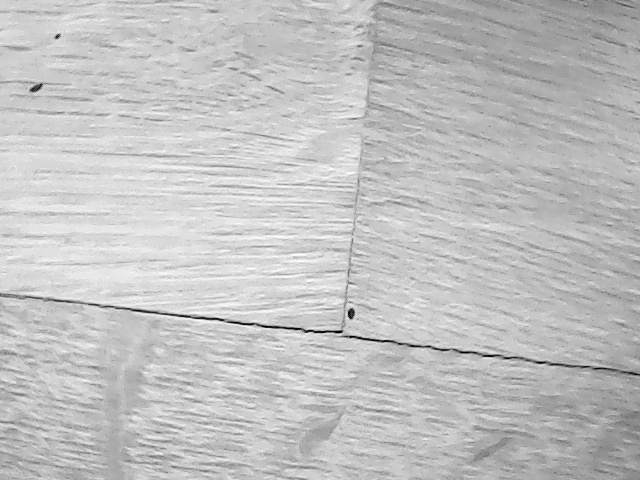result of recoverPose for 2D shifted image
I am trying to get odometry values using a ground watching cam (13 cm vertical distance) on a wooden floor. The cart has mecanum wheels and can move in 8 directions and additionally may rotate left and right. It has also inherent sliding with the wheels slighly pushing each other when moving, wheel rotation measure wont help much therefore. I can adjust speed to allow for small image delta.
I use feature_detector.detect on 2 conscutive images, do a calcOpticalFlowPyrLK, findEssentialMat and recoverPose.
Thought I could use the result of recoverPose (R, t) to find the x/y values travelled.
I however end up with nonfitting values. The only thing I was able to evaluate is the Z-rotation (roll) between 2 images using a rotationMatrixToEulerAngles function in combination with getRotationMatrix2D and my angles[2] value.
Example of image 1 and 2, image 2 is taken with cam moving left. Distance to floor is 13 cm, cam is 640480 pix and covers about 117 cm of the floor and I expected to get a 2cm x-movement to be detected resp. a yaw between 8 and 9 degrees?.


resulting t vector [[ 0.8696361 ] [ 0.09754516] [-0.48396074]]
resulting R matrix
[[ 9.94251600e-01 -1.65265050e-02 -1.05785777e-01]
[ 1.63426435e-02 9.99863057e-01 -2.60472019e-03]
[ 1.05814337e-01 8.60927979e-04 9.94385531e-01]]
my calculated rotation angles in degrees:
[-6.07408602 0.04960604 0.94169341]
my essential code:
def evalDistance(img1, img2):
feature_detector = cv2.FastFeatureDetector_create(threshold=25, nonmaxSuppression=True)
lk_params = dict(winSize=(21, 21),
criteria=(cv2.TERM_CRITERIA_EPS |
cv2.TERM_CRITERIA_COUNT, 30, 0.03))
keypoint1 = feature_detector.detect(img1, None)
keypoint2 = feature_detector.detect(img2, None)
p1 = np.array(list(map(lambda x: [x.pt], keypoint1)), dtype=np.float32)
p2, st, err = cv2.calcOpticalFlowPyrLK(img1, img2, p1, None, **lk_params)
E, mask = cv2.findEssentialMat(p2, p1, camera_matrix, cv2.RANSAC, 0.999, 1.0, None)
points, R, t, mask = cv2.recoverPose(E, p2, p1, camera_matrix)

You're going to have to describe the geometry a bit more clearly. Also, you should post an example of what you've tried so we can see if there's something wrong there.
Okay, so first question. Is your camera_matrix from a proper camera calibration? Or did you just guess?
Second, how sure are you it's pointing straight down? Try setting an aruco marker or chessboard on the floor under it and use that to figure out the distance from the camera to the plane of the floor at any point in the image. Once you have a function that can, given a pixel (x,y) give you the distance to the floor we can go to the next step.
Thanks for your feedback.
I did a camera calibration with an Aruco chessboard, yes.
The camera "more or less" points directly down.
I had the feeling I might be using the wrong functions for this type of problem and did some more investigation. Found finally this site:
https://docs.opencv.org/3.0-beta/doc/...
which looked to be much closer to what I am trying to achieve. I gave it a try and first results are very encouraging. So I will do more testing and adjusting with this approach.